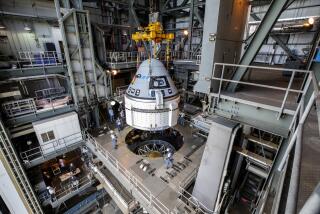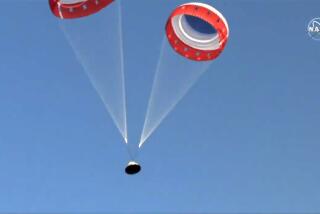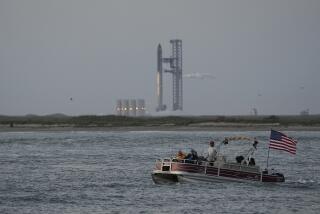Shuttle Probe Narrows to Faulty Booster Rocket Joint
WASHINGTON â The external fuel tank has been cleared of blame in the Challenger disaster and the probe has narrowed to a faulty booster rocket joint, possibly opened by the stresses of strong high-altitude winds, NASA engineers said Friday.
They told the presidential commission investigating the Jan. 28 accident that the precise cause of the failure of two rubber O-ring seals to contain the fiery gases in the booster was still not known, but that several possibilities were under scrutiny.
All focused on the joint between the lower two of the four segments that made up the shuttleâs right solid-fueled booster.
âIn the next week to 10 days we hope to get a significant amount of data relative to these prime scenarios,â said Wayne Littles, chief engineer at NASAâs Marshall Space Flight Center in Huntsville, Ala.
âI think thatâs been real progress since the last session,â said panel Chairman William Rogers at the conclusion of a five-hour public hearing at the State Department. The commissionâs last public hearing was held earlier this month at Cape Canaveral.
Among the possibilities still under consideration are cold weather effects on the O-rings, ice in the joint, damage to the seals during rocket assembly and defects in putty between the O-rings and the open interior of the rocket.
âI think itâs coming together quite well and I think over the next one to two weeks weâll be seeing a lot of results from the test program,â James Thompson, vice chairman of NASAâs failure task force, told the panel.
The commission, which is to report its findings to President Reagan by June 3, has asked NASA to complete its testing and report the results by April 18.
Littles said extensive testing has ruled out the possibility that the 184-foot fuel tank developed a leak before blastoff to set the stage for the rocket rupture.
The tank eventually did leak 64 seconds into the flight, but that was after the blowtorch-like jet from the booster rocket burned a hole in the tank, according to Dan Germany, head of NASAâs photo evaluation committee. The entire tank exploded 73 seconds after blastoff, destroying Challenger.
Harold Scofield, chief of control systems at Marshall, said the shuttle was buffeted by âa busy windâ as it climbed over the Atlantic, but he said the stresses were within the shuttleâs design limits.
âWorking on Itâ
âIf you had a weakened joint that sealed itself at liftoff, this could very well be the factor that opened that joint, is that right?â asked Air Force Maj. Gen. Donald Kutyna, a commission member.
âWeâre very much interested in that theory,â Scofield replied. âWeâre working on it.â
Frederick Bachtel, another Marshall engineer, said one series of tests indicated that it was highly unlikely a rocket joint leak developed at liftoff, as indicated by smoke at the time, and then continued for 73 seconds.
Littles concurred. âI think itâs possible based on what weâve seen that you have had a leak that stopped and started some time later,â he said.
Littles also said Marshall engineers were aware of problems with the O-rings before the Challenger accident because there was previous evidence of some O-ring damage during shuttle flights.
Flight Reviews
âSo itâs your opinion that that concern was generally known both at Marshall and Thiokol (the booster builder)?â Rogers asked.
âYes sir,â Littles replied. âI canât imagine that it was not known because it has been, I know, covered in flight-readiness reviews. We always discuss any anomalies that we had. I personally could not imagine anyone not being aware of a flight anomaly.â
Rogers, a former attorney general under Dwight D. Eisenhower and secretary of state under Richard M. Nixon, said several shuttle commanders have said they were unaware of O-ring problems before Jan. 28.
âWere you surprised or are you surprised now when you learn that a commander of one of the space shuttles was not told after the fact what had happened in connection with the O-rings on his particular flight? Does that surprise you today?â
Overlooked Flaw
âIt would surprise me, as a matter of fact,â Littles told Rogers.
âOK, weâll come to that later on in the investigation,â Rogers said.
Rogers also said the commission may decide to consider whether NASAâs contractors are adequately supervised. He made the comment after it was revealed that an examination of the pre-launch data on Challengerâs external tank found that an X-ray image had detected an overlooked flaw in the tankâs skin.
Littles said, however, that the imperfection was not involved in the accident.
âI think thatâs one of the things the commission will want to focus on in its report, whether we need to beef up the supervision of the contractors,â Rogers said.
More to Read
Sign up for Essential California
The most important California stories and recommendations in your inbox every morning.
You may occasionally receive promotional content from the Los Angeles Times.










